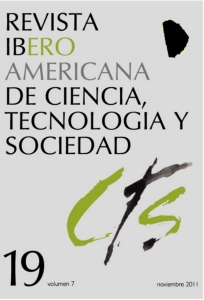La estructura hermenéutica de los sistemas vivos y los artefactos técnicos
DOI:
https://doi.org/10.52712/issn.1850-0013-733Palabras clave:
círculo hermenéutico, sistemas vivos y artefactos, Wolfgang Iser, espiral recursiva y cibernéticaResumen
La hermenéutica tiene una larga tradición en el intento de decodificar textos para hacerlos comprensibles. A partir de Schleiermacher, la tarea hermenéutica se relaciona con el intento de describir el modo en que lo ajeno, lo extraño, se traduzca en algo familiar a partir de la forma del círculo hermenéutico. La interpretación, de este modo, se muestra como la traducción de una cosa en otra. Este modelo de la interpretación como traducción bajo la forma del círculo hermenéutico es lo que se intentará aplicar en este trabajo a un ámbito distinto de los textos: los sistemas vivos y los artefactos. Para ello, seguiremos el trabajo de Wolfgang Iser y utilizaremos su noción de espiral recursiva junto a la de espiral cibernética como géneros derivados de la forma del círculo hermenéutico susceptibles de explicar la dinámica interpretativa del hombre en su control del medio ambiente.
Descargas
Citas
DILTHEY, W. (2000): Dos escritos sobre hermenéutica. El surgimiento de la hermenéutica y los Esbozos para una crítica de la razón histórica (ed. bilingüe), Madrid, Istmo.
FERRARIS, M. (2002): Historia de la hermenéutica, México, Siglo XXI.
GADAMER, H. G. (1975): Wahrheit und Methode, Tubinga, Mohr.
GEERTZ, C. (1973): The Interpretation of Cultures: Selected Essays, Nueva York, Basic Books.
ISER, W. (2000): The Range of Interpretation, Nueva York, Columbia University Press. [Traducción española (2005): Rutas de la interpretación, México, FCE]
GREISCH, J. (2001): El Cogito herido. La hermenéutica filosófica y la herencia cartesiana, Buenos Aires, UNSAM.
SCHLEIERMACHER, F. (1977): Hermeneutik und Kritik, Frankfurt, Suhrkamp.
SCHOLZ, O. (1999): Verstehen und Rationalität. Untersuchungen zu den Grundlagen von Hermeneutik und Sprachphilosophie, Frankfurt, Vittorio Klostermann.
VARELA, F. (1979): Principles of Biological Autonomy, Nueva York, Elsevier North Holland.
Descargas
Publicado
Cómo citar
Número
Sección
Licencia
Derechos de autor 2024 CC Attribution 4.0

Esta obra está bajo una licencia internacional Creative Commons Atribución 4.0.
Todos los números de CTS y sus artículos individuales están bajo una licencia CC-BY.
Desde 2007, CTS proporciona un acceso libre, abierto y gratuito a todos sus contenidos, incluidos el archivo completo de su edición cuatrimestral y los diferentes productos presentados en su plataforma electrónica. Esta decisión se sustenta en la creencia de que ofrecer un acceso libre a los materiales publicados ayuda a un mayor y mejor intercambio del conocimiento.
A su vez, para el caso de su edición cuatrimestral, la revista permite a los repositorios institucionales y temáticos, así como también a las web personales, el auto-archivo de los artículos en su versión post-print o versión editorial, inmediatamente después de la publicación de la versión definitiva de cada número y bajo la condición de que se incorpore al auto-archivo un enlace a la fuente original.











